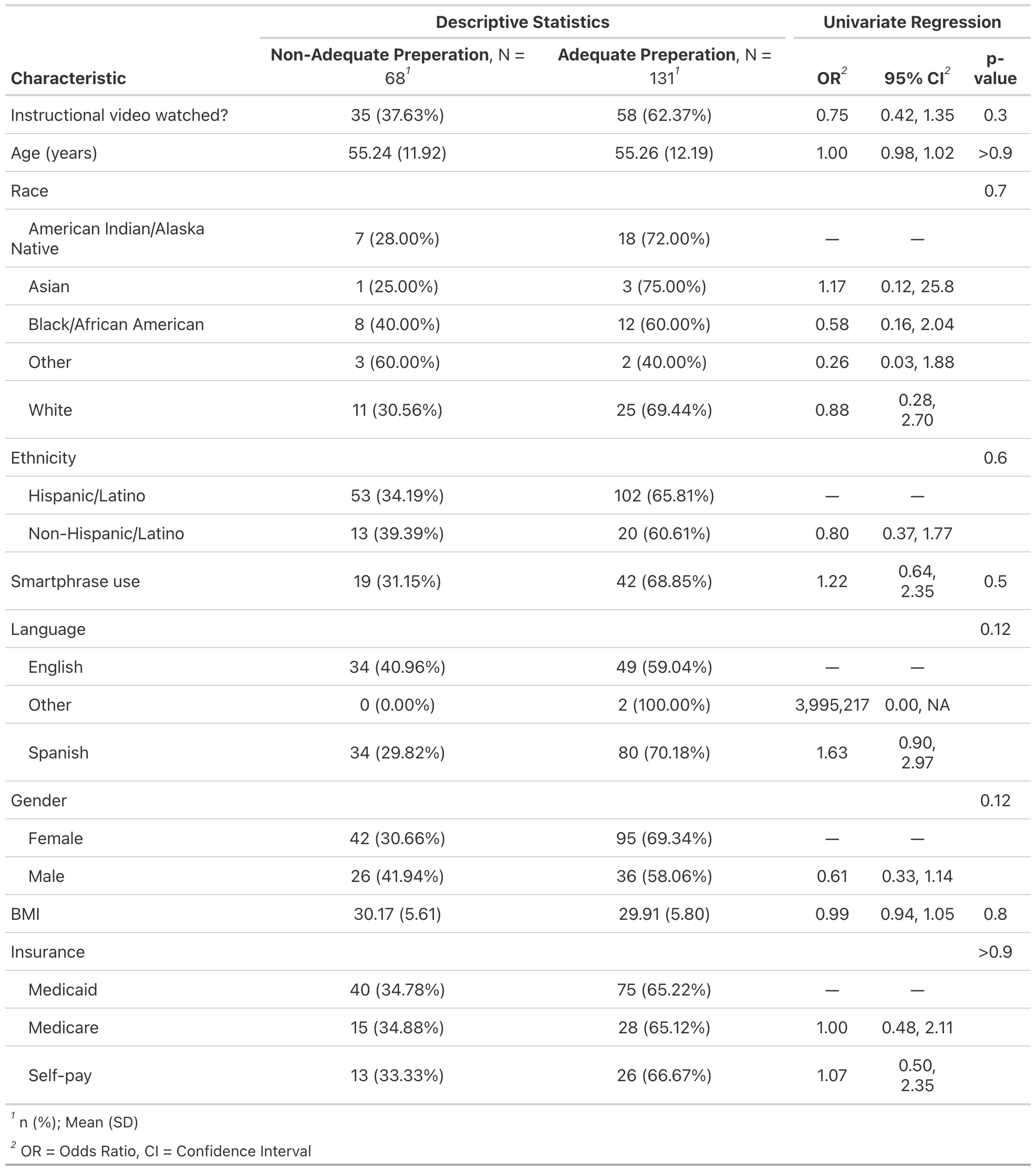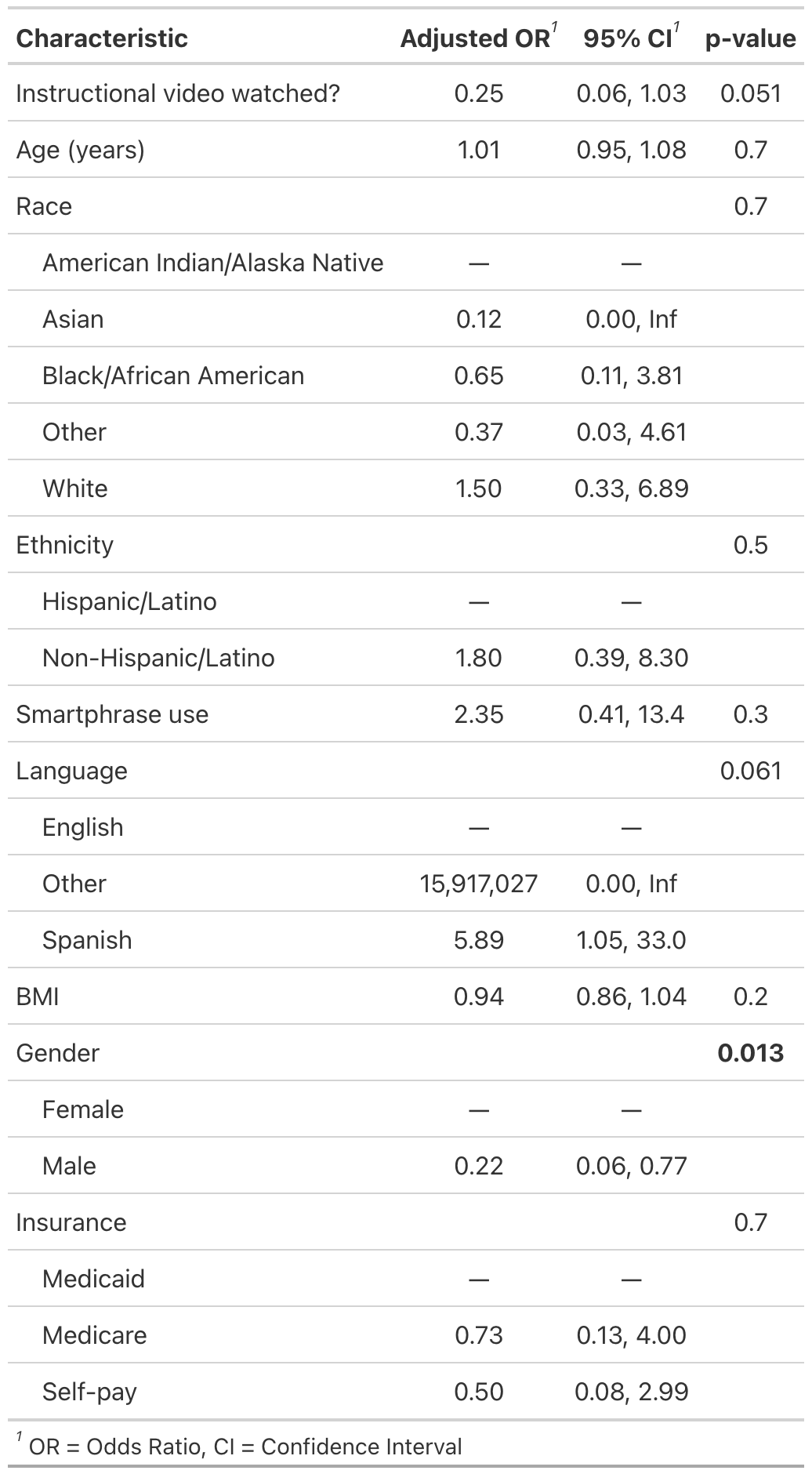Monday Poster Session
Category: Colorectal Cancer Prevention
P2613 - Impact of a Bilingual Instructional Video on Bowel Preparation Quality in a Diverse Urban Population
Monday, October 27, 2025
10:30 AM - 4:00 PM PDT
Location: Exhibit Hall

Naveena Luke, MD (she/her/hers)
NYU Grossman School of Medicine
Brooklyn, NY
Presenting Author(s)
Naveena Luke, MD1, Ixel Cervera, MD2, Leora Aquino, MD2, Xucong Meng, MPH3, Aasma Shaukat, MD, MPH, FACG4
1NYU Grossman School of Medicine, Brooklyn, NY; 2Family Health Centers at NYU Langone, Brooklyn, NY; 3NYU Grossman School of Medicine, New York, NY; 4NYU Grossman School of Medicine, Division of Gastroenterology and Hepatology, New York, NY
Introduction: Suboptimal bowel preparation impairs colonoscopy effectiveness and increases repeat procedures. Educational interventions such as instructional videos may improve prep quality, particularly in populations with linguistic and health literacy barriers. This study evaluated whether viewing a brief, bilingual colonoscopy preparation video improved bowel preparation and adequacy, as measured by the Boston Bowel Preparation Scale (BBPS).
Methods: We conducted a retrospective analysis of 199 patients undergoing outpatient colonoscopy at a safety-net hospital. Patients were stratified by whether they viewed a validated English/Spanish video explaining preparation steps. The primary outcome was BBPS score, both as a continuous measure and a binary outcome (adequate = total score ≥6 and all segment scores ≥2). Welch’s t-test compared mean BBPS scores between groups. Logistic regression models assessed predictors of adequate prep, adjusting for demographics, BMI, language, and smartphrase use.
Results: The video group had significantly higher mean BBPS scores compared to the non-video group (7.28 vs 6.61; p = 0.0039). In univariate logistic regression, video viewing was not significantly associated with prep adequacy (OR 0.75, 95% CI 0.42 - 1.35), but trended toward significance in multivariate analysis (adjusted OR 0.25, 95% CI 0.06 - 1.03; p = 0.051), suggesting possible confounding. Spanish speakers had markedly higher odds of adequate prep (aOR 5.89, 95% CI 1.05 - 33.0), while male gender was associated with lower prep adequacy (aOR 0.22, 95% CI 0.06 - 0.77; p = 0.013). Age, race, BMI, and insurance type were not independently associated with outcomes.
Discussion: Patients who viewed the instructional video had significantly better bowel preparation, as reflected by higher mean BBPS scores. Although video viewing was not independently associated with prep adequacy in adjusted models, the trend suggests potential benefit. These findings support further study and wider implementation of accessible, multilingual educational tools to improve colonoscopy preparation quality in diverse patient populations.

Figure: Figure 1. Univariate analysis of patient and intervention characteristics associated with adequate bowel preparation.

Figure: Figure 2. Multivariate logistic regression analysis of predictors of adequate bowel preparation.
Disclosures:
Naveena Luke indicated no relevant financial relationships.
Ixel Cervera indicated no relevant financial relationships.
Leora Aquino indicated no relevant financial relationships.
Xucong Meng indicated no relevant financial relationships.
Aasma Shaukat: Freenome inc – Consultant.
Naveena Luke, MD1, Ixel Cervera, MD2, Leora Aquino, MD2, Xucong Meng, MPH3, Aasma Shaukat, MD, MPH, FACG4. P2613 - Impact of a Bilingual Instructional Video on Bowel Preparation Quality in a Diverse Urban Population, ACG 2025 Annual Scientific Meeting Abstracts. Phoenix, AZ: American College of Gastroenterology.
1NYU Grossman School of Medicine, Brooklyn, NY; 2Family Health Centers at NYU Langone, Brooklyn, NY; 3NYU Grossman School of Medicine, New York, NY; 4NYU Grossman School of Medicine, Division of Gastroenterology and Hepatology, New York, NY
Introduction: Suboptimal bowel preparation impairs colonoscopy effectiveness and increases repeat procedures. Educational interventions such as instructional videos may improve prep quality, particularly in populations with linguistic and health literacy barriers. This study evaluated whether viewing a brief, bilingual colonoscopy preparation video improved bowel preparation and adequacy, as measured by the Boston Bowel Preparation Scale (BBPS).
Methods: We conducted a retrospective analysis of 199 patients undergoing outpatient colonoscopy at a safety-net hospital. Patients were stratified by whether they viewed a validated English/Spanish video explaining preparation steps. The primary outcome was BBPS score, both as a continuous measure and a binary outcome (adequate = total score ≥6 and all segment scores ≥2). Welch’s t-test compared mean BBPS scores between groups. Logistic regression models assessed predictors of adequate prep, adjusting for demographics, BMI, language, and smartphrase use.
Results: The video group had significantly higher mean BBPS scores compared to the non-video group (7.28 vs 6.61; p = 0.0039). In univariate logistic regression, video viewing was not significantly associated with prep adequacy (OR 0.75, 95% CI 0.42 - 1.35), but trended toward significance in multivariate analysis (adjusted OR 0.25, 95% CI 0.06 - 1.03; p = 0.051), suggesting possible confounding. Spanish speakers had markedly higher odds of adequate prep (aOR 5.89, 95% CI 1.05 - 33.0), while male gender was associated with lower prep adequacy (aOR 0.22, 95% CI 0.06 - 0.77; p = 0.013). Age, race, BMI, and insurance type were not independently associated with outcomes.
Discussion: Patients who viewed the instructional video had significantly better bowel preparation, as reflected by higher mean BBPS scores. Although video viewing was not independently associated with prep adequacy in adjusted models, the trend suggests potential benefit. These findings support further study and wider implementation of accessible, multilingual educational tools to improve colonoscopy preparation quality in diverse patient populations.

Figure: Figure 1. Univariate analysis of patient and intervention characteristics associated with adequate bowel preparation.

Figure: Figure 2. Multivariate logistic regression analysis of predictors of adequate bowel preparation.
Disclosures:
Naveena Luke indicated no relevant financial relationships.
Ixel Cervera indicated no relevant financial relationships.
Leora Aquino indicated no relevant financial relationships.
Xucong Meng indicated no relevant financial relationships.
Aasma Shaukat: Freenome inc – Consultant.
Naveena Luke, MD1, Ixel Cervera, MD2, Leora Aquino, MD2, Xucong Meng, MPH3, Aasma Shaukat, MD, MPH, FACG4. P2613 - Impact of a Bilingual Instructional Video on Bowel Preparation Quality in a Diverse Urban Population, ACG 2025 Annual Scientific Meeting Abstracts. Phoenix, AZ: American College of Gastroenterology.

